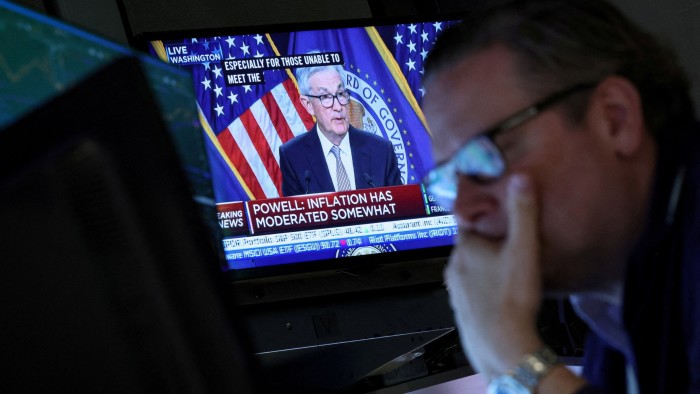Investors still need to adjust to a world of higher interest rates

Roula Khalaf, Editor of the FT, selects her favourite stories in this weekly newsletter.
The writer is chief economic strategist at Netwealth
There needs to be a prolonged period of positive real interest rates in western economies. That is, policy rates will need to remain higher than inflation for some time. Not now, but once we see where core inflation settles. Markets will need to factor this in fully.
The end of cheap money is the dominant issue, driven by the need to restore anti-inflationary credibility to policy. Two aspects stand out. One is where rates will peak and whether central banks have done enough to curb inflation.
Tightening through higher policy rates could end soon. Globally, headline inflationary pressures are easing. Freight rates and oil prices are low. The UN’s measure of food prices is 22.1 per cent below its March 2022 all-time high.
China, which maintained a prudent monetary policy during the pandemic, has just eased and is likely to cut its reserve requirement ratios for banks again, providing liquidity. While many countries are likely to have seen policy rates already peak, central banks are reluctant to signal easing. Take India. It has seen inflation ease to a 25-month low of 4.25 per cent but policy is on hold.
The persistence of core inflation is keeping central banks in the west cautious. The initial drivers of this global inflation bout have been reversed, namely supply-side factors and lax monetary policies. However, second-round inflation effects are feeding into core inflation in economies such as the UK. Rising inflation expectations and tight labour markets are feeding wage growth and companies appear able to pass on higher costs, thus maintaining or boosting profit margins.
Despite criticism, the US Federal Reserve was sensible to pause. There is considerable policy tightening in the pipeline that will slow the economy. But it will raise rates if its aggressive tightening to date does not curb core inflation.
The Fed’s credibility allows it to pause. In contrast, the Bank of England lacks any credibility and so has not been able to pause. So further rises look likely, with recession possible.
The second key issue warrants more attention. Future monetary policy neutrality points to the need for real positive interest rates. This is in addition to central banks shrinking their balance sheets.
Markets may thus no longer be able to rely upon monetary policy as being the inevitable shock absorber, where rates are cut in response to economic weakness or financial stress. If so, expect more policy pressures and market volatility.
It is quite possible that inflation in many western economies, including the US, euro area and the UK, may settle at a higher level than before the pandemic, and above the 2 per cent where markets always seem to expect inflation to return to. If so, expect talk of higher targets.
When the inflation environment changes, expectations can adjust slowly. This was the case in the 1970s. It was also the case in the early 1990s. Then I was in a small group of economists who believed we were moving to a new era of low inflation and was struck by how long it took market thinking to adjust. It kept expecting inflation to return to its previous higher levels globally. Likewise now. Two per cent is ingrained in thinking. Perhaps this should now be 3 per cent.
For a quarter of a century, inflation has been low because of globalisation, the squeeze on wage shares, financialisation and technology. Two of these four are changing, with globalisation replaced by fragmentation and wage shares rising. A 1977 article by economist Bob Rowthorn seems relevant now, highlighting the conflict between workers and owners and how they anticipate inflation and react.
Also, markets are mindful of the group thinking that has characterised central banks. Before the pandemic there was agreement that R-star, the real neutral rate of interest that is consistent with stable economic conditions, was zero in most western economies. So if inflation settled at 3 per cent, policy rates would be 3 per cent. But an R-star of close to zero is a policy outcome that reflects deeply flawed thinking because of the distortions that arise from cheap money. That thinking has been at the heart of the problems we have seen.
Cheap money led to asset price inflation, to markets not pricing properly for risk and to a misallocation of capital. It also contributed significantly to the recent bout of inflation. The last thing the world economy needs is a return to cheap money.
Lower inflation will contribute to positive policy rates. But that is unlikely to be the whole story. This is about a credible shift in thinking that keeps policy rates higher than markets have become used to since the 2008 global financial crisis.
Comments